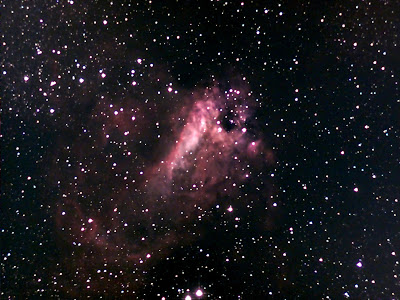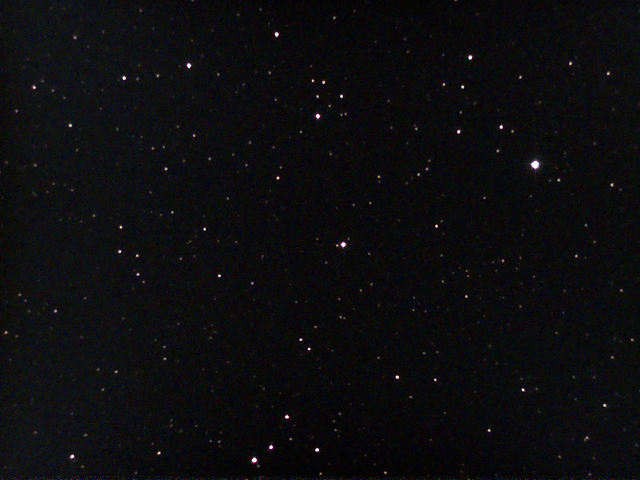Note: All of the images in this post, with the exception of the two star maps
and the one image from the Hubble Space Telescope, were taken by me with
my 4.5" Unistellar eVscope.
In the 1700s a French comet hunter named Charles Messier compiled a list of things in the night sky that aren’t comets. As someone who was actively looking for comets, this represented his list of things that could be ignored because they aren’t what comet hunters want to find. His list of not-comets is a catalog of more than 100 objects that represent some of the finest objects in the night sky. The list is mostly made up of star clusters and galaxies, but there are 12 nebulae.
Nebulae (that’s the plural for nebula) are clouds of gas. They come in
different types and the 12 that are found on in the Messier nicely
represent them. Here are images of the 12 Messier nebulae and I decided
to rank them, because, why not? (Note: there are some other nebulae that are sort of in the catalog. For instance there's a little nebula that can be seen when looking at open star cluster M46, but I decided not to include those here.)
 |
The 12 Nebulae of the Messier Catalog in numerical order.
|
 |
| M78 |
Number 12: M78. M78 is dark and moody. It’s the kind of nebula that is okay with the fact that it doesn’t have a widely used proper name. It’s nothing more than a reflection nebula, something that is produced as light from its two central stars passes through the dust. Darker clouds of dust surround the brighter region cloaking M78 in mystery (except when viewed in the infrared. There's an entire cluster of stars there).
 |
M43 is the little luminous blob in the middle.
|
Number 11: M43, De Mairan’s Nebula. Who was De Mairan? I confess that I had to look him up. Jean-Jacques Dortous de Mairan discovered this nebula (according to Wikipedia “some time before 1731"), but frankly this nebula really shouldn’t be classified as its own thing. I mean it’s right there with the fabulous M42. There’s some dark interstellar dust that makes M43 seem like a separate thing, but they really are connected making M43 somewhat of a poser on the edge of greatness.

Number 10: M76, the Little Dumbbell Nebula. That's "dumbbell", as in barbell and as in M27, the actual (not little) Dumbbell Nebula, which we’ll get to later. M76 is a planetary nebula which, as I tell my students, has nothing to do with planets at all. Many of these nebulae are small and round and blueish green in color, much like the planet Uranus. Sir William Herschel, who discovered Uranus, thought that these looked a bit like his planet, so he gave them the name planetary nebulae. Because of this astronomy students have hated him for years.
In a planetary nebula gas is being ejected out from a dying star. The hot core of the dying star heats the surrounding gas and makes it glow like the gas of a neon sign. M76 is small, but it has distinct colors that are easily revealed with the eVscope making it a nice target.
 |
Owl Nebula with a satellite photobombing the image.
|
Number 9: M97, the Owl Nebula. The Owl is another planetary nebula and gets its distinctive name from two large dark areas like “eyes” that make it somewhat reminiscent of an owl’s face. It is faint and takes some time to really see it well, but it is a cool thing nonetheless.
 |
M1, the Crab Nebula
|
Number 8: M1, the Crab Nebula. The Crab gets extra points for being the only supernova remnant in the bunch, but let’s be honest, it looks nothing like a crab. It was produced when a star exploded as seen from Earth on July 4, 1054 A.D. The eVscope reveals it easily, though it takes some time to see much color here. No matter how you slice it, it is cool to observe a hot cloud of expanding star guts.
 |
M20, the Trifid Nebula
|
Number 7: M20, the Trifid Nebula. Stars. Gas. Dust. The Trifid has it all. The red comes from a glowing cloud of hydrogen gas which is cut across by dark dust lanes, that help to give it its distinctive name (Trifid means tri-lobed). The faint blue color comes from starlight shining through dust (like sunlight shining through a dirty car windshield), similar to what we saw in M78. It’s an all-round good nebula.
Number 6: M27, the Dumbbell Nebula. Like M76, the name means barbell, though according to Wikipedia it is sometimes known as the Apple Core Nebula, which is a name I like much better than Dumbbell. Alas, I’ve never actually heard anyone use that name and I fear that if I start calling it the Apple Core Nebula no one will know what I am talking about. It’s another planetary nebula. As you can see it is a big (about 1 light year across) bubble of gas seen against a dense field of stars.
Let’s face it, bubbles are cool and this is likely one of the biggest you’ll ever see. Of the planetary nebulae in the Messier catalog, this one is the closest which also makes it the one that has the largest apparent size.
Number 5: M17, the Omega Nebula (also called the Swan and other names too). This giant cloud of hydrogen gas is a site of active star formation which means that the nebula is converting itself into a cluster of stars. It has already formed many stars, but they are largely hidden by the nebula itself. Some of the younger, hotter stars that have formed shine on the gas cloud and make it glow.
 |
M17, the Omega Nebula
|
 |
Location of the Ring Nebula. Image from SkySafari Pro.
|
Number 4: M57, the Ring Nebula. The Ring is awesome. It is another planetary nebula, so we are seeing gas that has been ejected by a dying star. The Ring always impresses people when they see it through a telescope. I remember once years ago (when I was working at Lake Afton Public Observatory in Wichita, Kansas) I was using a 16-inch telescope to show the Ring Nebula to a young lad who then described it as looking like a “dimly-lit Cheerio.” His description was perfect and much better than the “smoke ring” description that most people use. Of course, the eVscope quickly reveals its colors (something you won’t see at the eyepiece of traditional telescopes). This color perhaps makes M57 more like a Froot Loop than a Cheerio.
Bonus points are given to the ring for being so easy to find in the sky, it is easily found even without using a go-to telescope. It is nestled between two stars in the parallelogram of Lyra, the Harp.
 |
M57, the Ring Nebula
|
Number 3: M16, the Eagle Nebula. No star death here. Like M17, the Eagle Nebula is a glowing cloud of gas that is actively giving birth to stars. In fact there’s a cluster of baby stars (NGC 6611) that have already emerged from the nebula. This nebula was made famous by the “Pillars of Creation” image from the Hubble Space Telescope. The pillars are easily visible in my image. Here’s a comparison of my image next to the one from Hubble. The Hubble image is presented in a different and not very realistic color palette, but it beats my image in every possible way (as it should). Still it is nice to capture something that famous with my little telescope. The Pillars themselves are 4-5 light years long and are sites of active star formation in the nebula.
 |
M16, the Eagle Nebula
|
Number 2: M8, the Lagoon Nebula. While I didn't rank this as number 1, I confess that the Lagoon is perhaps my favorite. It is another star-forming nebula like we saw in M16 & M17, but it has so much more. There's good color, a prominent dark dust lane that cuts across it, a great star cluster (NGC 6530), dark clouds of dust that lurk at the edges of the main nebula, but also dark blobs of dust (called Bok Globules) that are revealed in silhouette. I like everything about this nebula. The region is too big to completely fit into the field of view of the eVscope. Below is a mosaic that I took of the area:
 |
Messier 8, the Lagoon Nebula
|
And the best Messier nebula is....
 |
Location of Orion Nebula (image from SkySafari Pro)
|
Number 1: M42, the Great Orion Nebula. When you have the word
"great" in your name there shouldn't be any doubt as to your status. The Orion
Nebula is bright and super easy to find. It sits in a prominent spot in
Orion, which is arguably the brightest and most famous constellation of
them all. Pretty much everyone can find the three stars that make up the
Belt of Orion. The Orion Nebula is the middle "star" of the Sword which
hangs down from the Belt. It is easily seen without any optical aid if you
are away from light polluted skies. It looks fine in binoculars and good
in every telescope.
Like the Lagoon, this nebula is too big to see all at once, so I took a mosaic of the region:
 |
M42, the Great Orion Nebula
|
Yes, M43 is hanging on there on the left, but it's really part of M42. The Great Orion Nebula, which like the Lagoon and the others we've seen, is a vast cloud of mostly hydrogen gas that is actively forming stars. The central white area is overexposed here, but it is home to a group of young stars called the Trapezium which are making the gas fluoresce. There's dark dust, blue reflected starlight and red glowing hydrogen.
It really is a stunning sight to see.
I am working my way through photographing the entire Messier Catalog, with only a few objects left to get. If I feel super energetic about it I might just rank all 110 of them.































